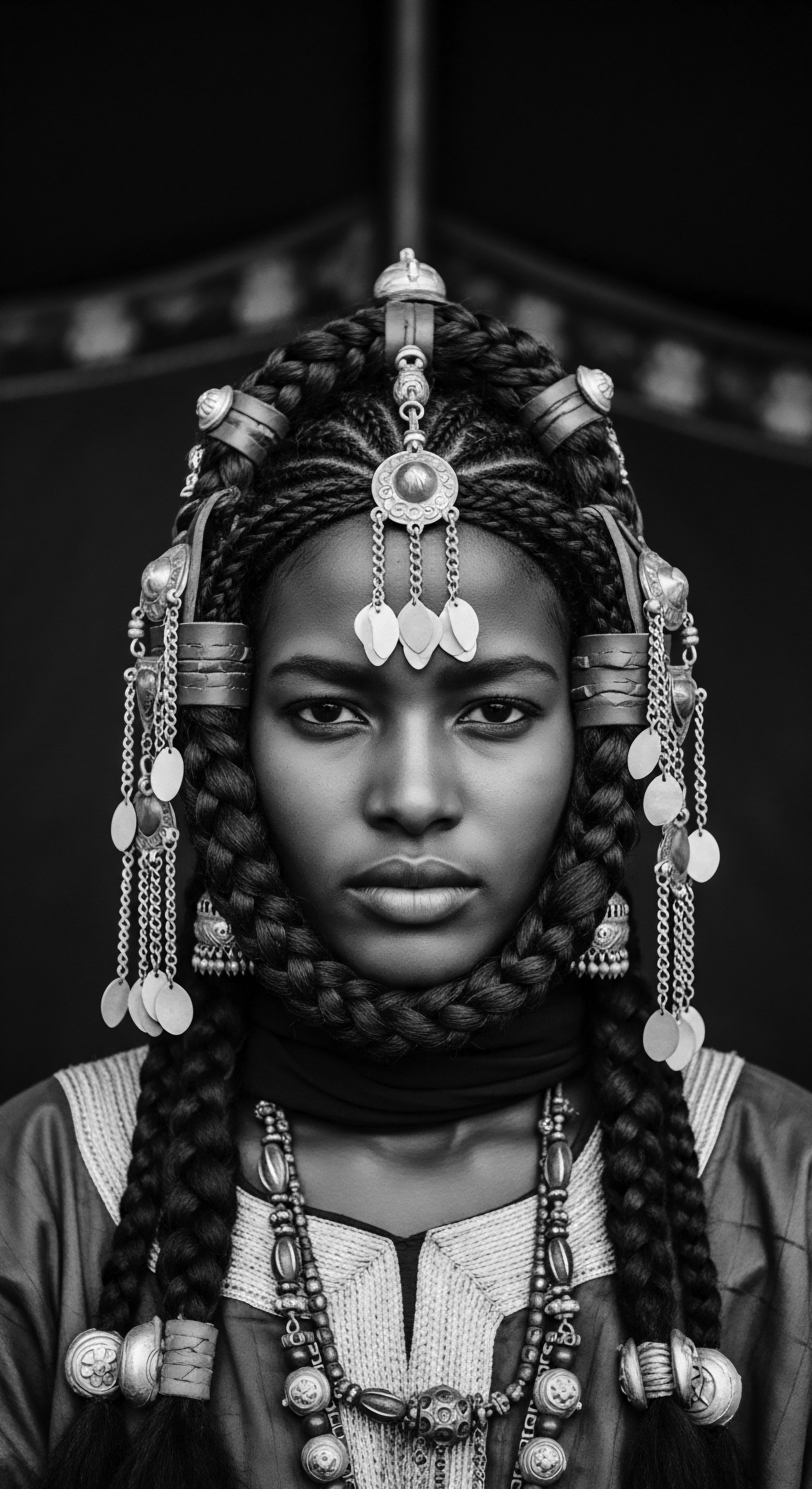
Roots
Feel the ancient earth beneath your feet, sense the whisper of generations carried on the wind, and let us attend to the sacred coils and vibrant textures that emerged from the very genesis of humanity. The textured hair of African peoples, in its infinite configurations, has always been a living archive, a profound repository of communal wisdom and individual standing. Long before the ink touched parchment or the loom hummed a song of trade, the human head, crowned with its unique fiber, served as a primary canvas for the stories of life, lineage, and cosmic connection. Each strand, each delicate curl, bore the weight of meaning, reflecting not only elemental biology but also a deep understanding of self within a collective.
The very structure of textured hair, characterized by its elliptical cross-section and unique curl patterns, made it a pliable medium for the intricate artistry seen across ancient African societies. This inherent biological truth dictated many traditional practices, shaping both the tools and techniques employed. Understanding the fundamental nature of these ancestral fibers provides a grounding for appreciating their symbolic weight. The diverse classifications we consider today—from the tightly coiled to the more loosely patterned—find their echoes in the distinct styling approaches developed by various ethnic groups, each recognizing and celebrating their hair’s particular heritage.
Hair practices in ancient African societies were deeply woven into the fabric of daily life, serving as tangible expressions of a person’s place within their community and their connection to the spiritual realm.
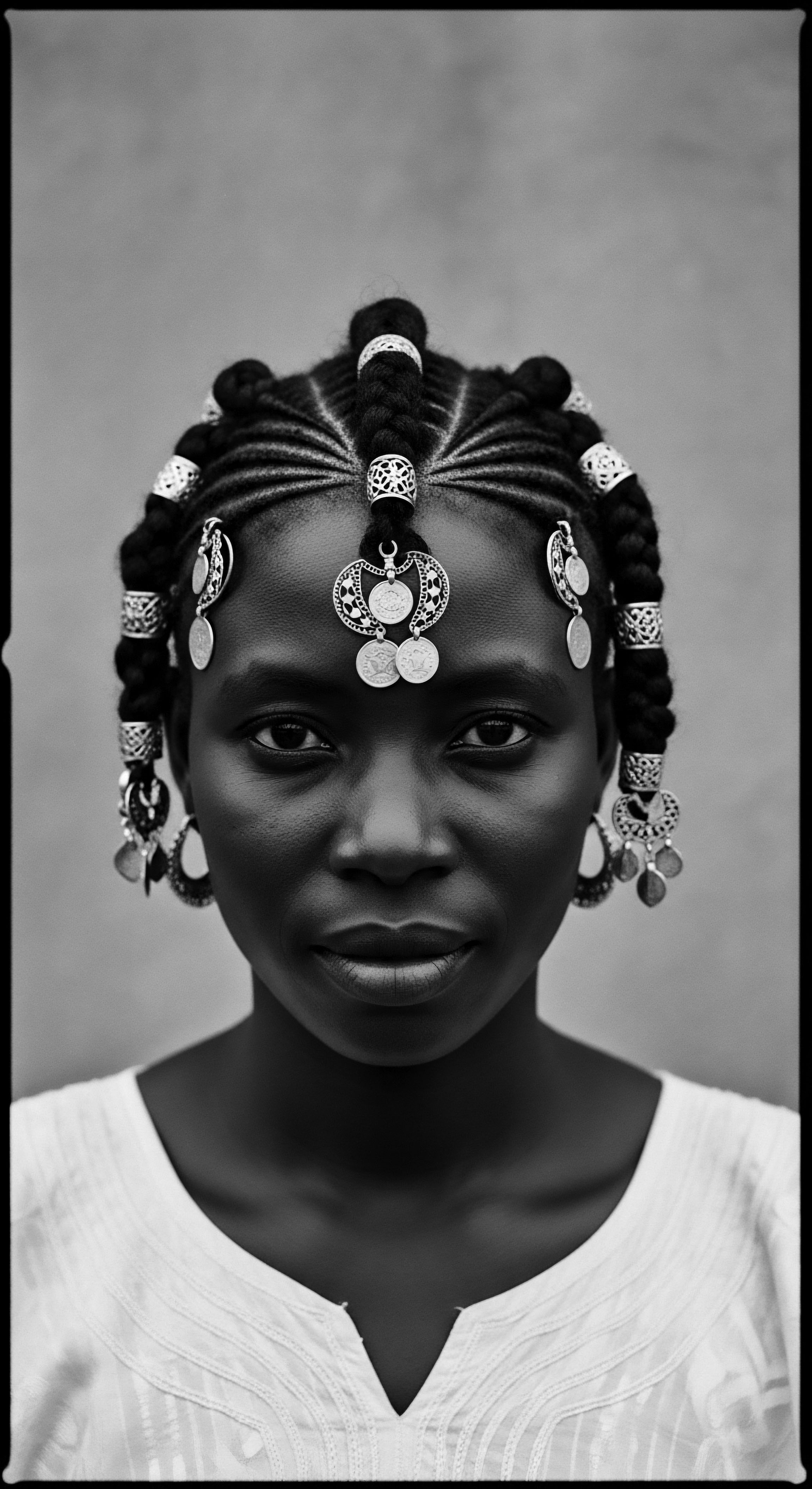
The Ancestral Strand’s Blueprint
What foundational attributes gave textured hair such symbolic power? The biological architecture of African hair, with its remarkable density and often spiraling growth, naturally lent itself to styles demanding patience and communal effort. Hair’s growth cycle, too, held cultural significance; the appearance of new growth or the deliberate maintenance of length could mark passage through life stages. The reverence for hair’s vitality was often tied to its perceived life force.
In West African communities, for instance, a woman with long, thick, well-kept hair often signified her ability to bear healthy children and cultivate bountiful farms, demonstrating a robust life force (EdwardAsare, 2021). This cultural understanding of hair’s inherent strength and potential was intrinsically linked to its biological reality.
The lexicon developed to describe these hair textures and their treatments was organic, born from generations of observation and tradition. Terms describing specific curl types, textures, or even the feeling of hair, varied from one linguistic group to another, each capturing the intimate relationship between the people and their crowns.
- Density ❉ The close packing of hair follicles provided a full, robust foundation for sculptural styles.
- Porosity ❉ Hair’s capacity to absorb moisture influenced the use of ancestral oils and butters for care and styling.
- Elasticity ❉ The natural spring of coiled strands allowed for innovative manipulation into complex patterns and shapes.

Early Manifestations of Identity
In ancient Egypt, a civilization whose legacy continues to astound, hairstyles stood as visible markers of hierarchy and divinity. The elite, both men and women, often wore elaborate wigs crafted from human hair, plant fibers, and even wool. These wigs, sometimes adorned with gold, beads, or other precious materials, announced wealth, spiritual devotion, and even a direct link to the gods.
The more intricate and decorated the coiffure, the higher one’s social standing. Pharaohs themselves wore stylized wigs or regal headdresses that broadcast their royal status and divine authority.
Moving south, the Kingdom of Kush, known for its powerful queens called Kandakes, also valued elaborate hairstyles as signs of status and affiliation. Kushite royalty, especially women, displayed complex headdresses and hairstyles that incorporated braids, locs, and various ornamental elements, reflecting both their tribal identity and spiritual beliefs. These elaborate displays were not merely aesthetic choices; they were profound statements, embodying lineage, power, and a people’s unique heritage.
| Society Ancient Egypt |
| Hair Practice Elaborate Wigs and Adornments |
| Symbolic Meaning Wealth, Divine Connection, Social Hierarchy |
| Society Kingdom of Kush |
| Hair Practice Braided and Loc'd Royal Styles |
| Symbolic Meaning Authority, Lineage, Tribal Identity |
| Society West African Tribes (General) |
| Hair Practice Varied Braiding Patterns |
| Symbolic Meaning Social Signals, Personal Identity |
| Society These foundational practices illustrate hair's role as a primary non-verbal communicator of heritage and societal standing. |
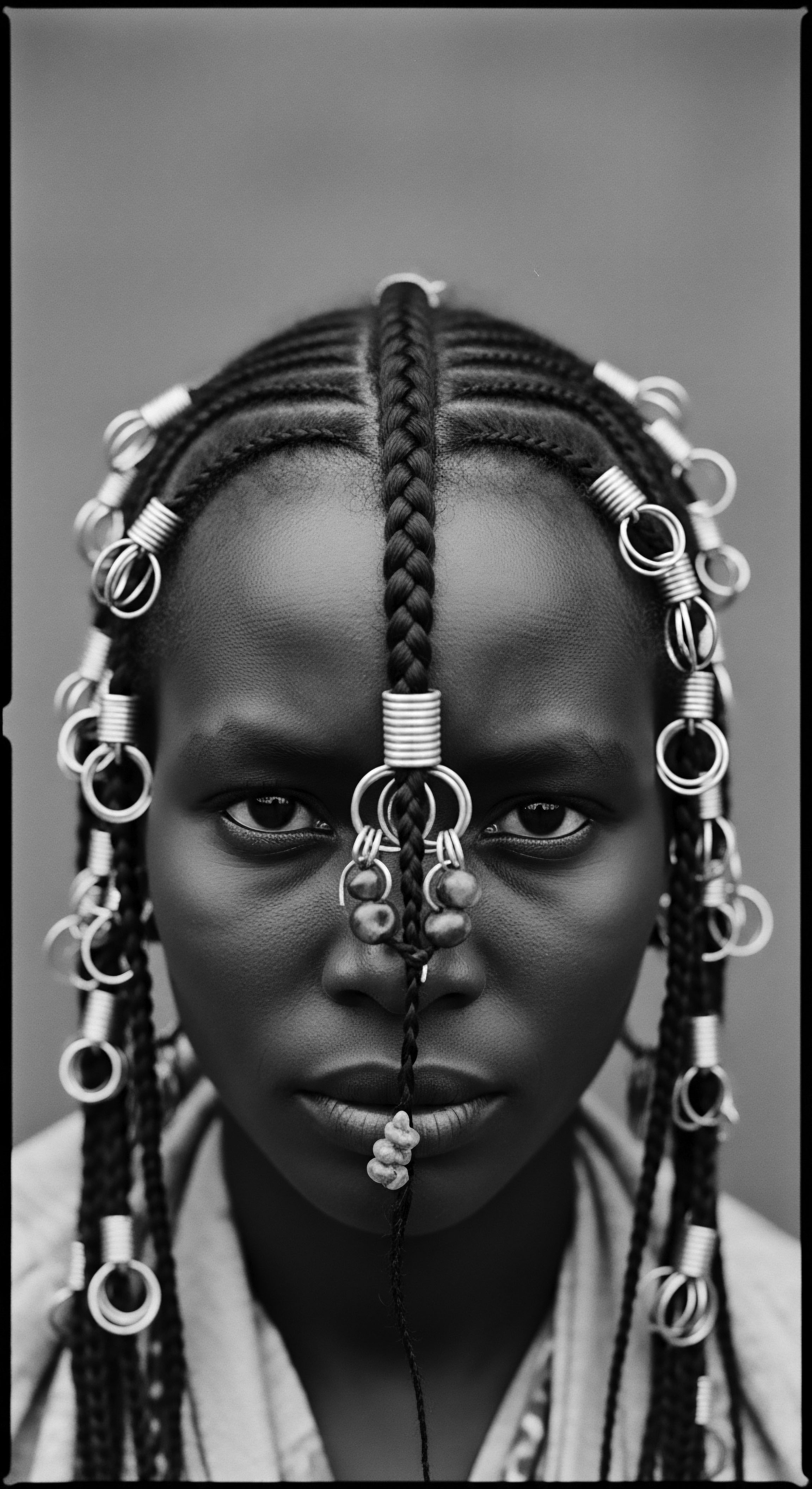
Ritual
The journey of textured hair through ancient African societies was a profound dance of ritual and purpose, where styling transcended mere appearance. Each twist, each braid, each application of ancestral unguents was a ceremonial act, often laden with community blessing and personal significance. These were not just techniques; they were living traditions, handed down through the tender thread of generations, shaping the living identities of individuals and communities alike. The very act of hair dressing was a social activity, a cherished opportunity for bonding and the quiet exchange of wisdom.

How Did Cultural Practices Imbue Hair with Identity?
Across West African societies, the artistry of braiding held a particularly deep heritage. Tribes such as the Yoruba, Wolof, and Fulani developed intricate patterns that held significant cultural and spiritual weight. These distinct styles conveyed a range of social signals. Among the Yoruba, for example, hairstyles held a deep spiritual resonance, often created by skilled braiders who commanded immense respect within their communities.
The Yorùbá understanding saw hair as an agentive part of the body, central to the understanding of the entire human framework. A traditional Yorùbá adage, “A kii di irun tabi ge irun leyin olori,” roughly translates to “one does not plait or cut a person’s hair without the consent of the owner of the head,” emphasizing hair as a powerful representation of the individual (FMACCE, 2021).
Protective styles, born from necessity and ingenuity, also doubled as powerful identity markers. Cornrows, with their enduring legacy, date back at least to 3000 BCE in parts of Africa. Beyond their practical benefits of safeguarding the hair, these linear designs communicated tribe, social standing, age, family background, and even spiritual conviction. The practice of braiding rice seeds into hair during the transatlantic slave trade, a profound act of resistance and survival, directly links this ancient art to the preservation of cultural heritage and the very continuation of life.
Traditional hair styling practices in ancient Africa served as intricate visual languages, communicating a wealth of social, spiritual, and personal information within communities.
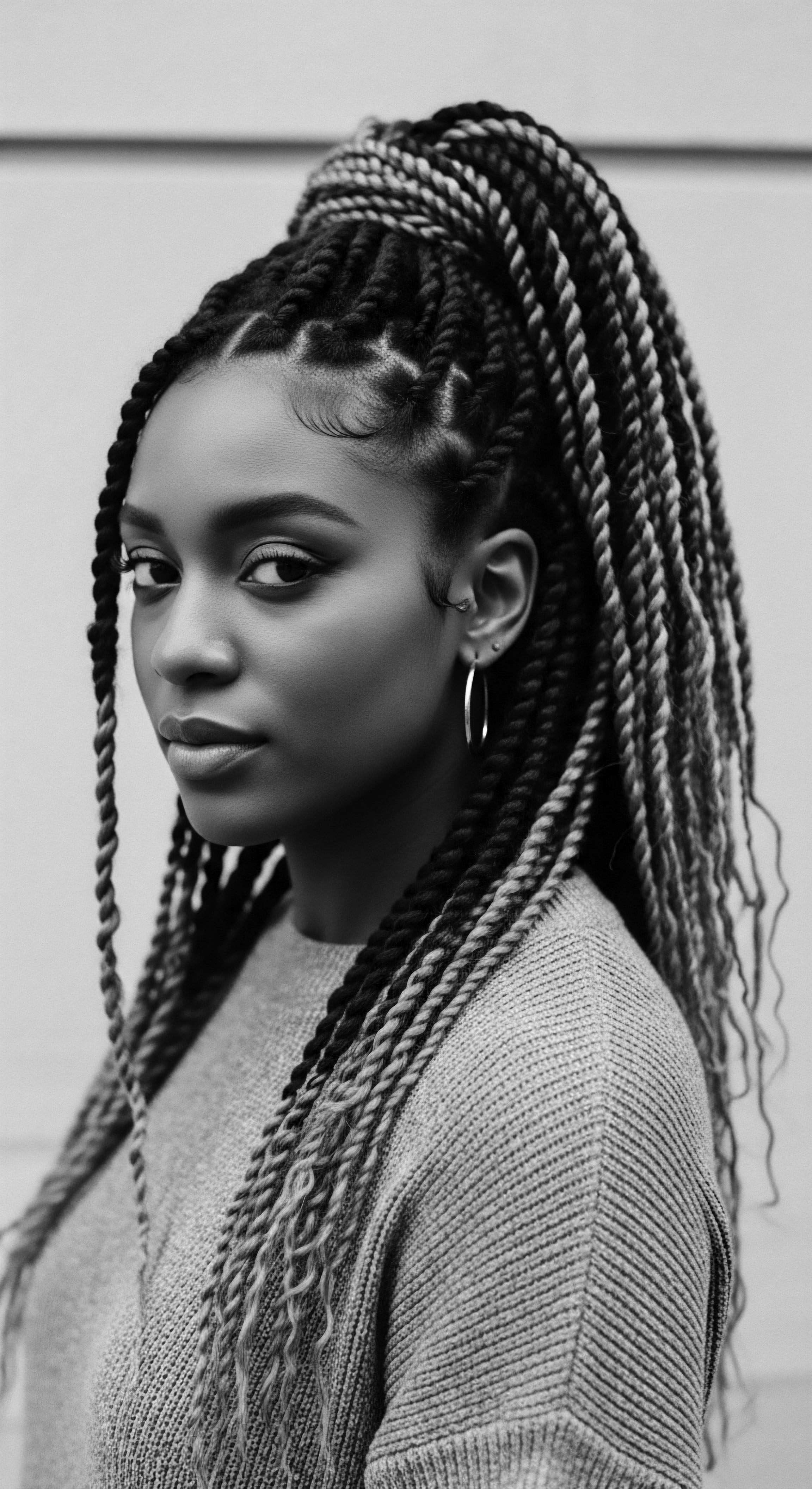
Styling as a Rite of Passage
Hair transformations often accompanied significant life transitions. In Yorùbá culture, the “Irun Kiko,” a form of thread-wrapping, not only stood out visually but carried meaning related to femininity, marriage readiness, and coming-of-age rites. Braids could signal a woman’s marital status, her fertility, or her standing within the community. Young women often wore elaborate braids during initiation ceremonies, marking their transition to adulthood.
The Himba people of Namibia offer another compelling instance of hair as a life chronicle. Their distinct dreadlocked styles, coated with a mixture of red ochre paste, goat hair, and butter, stand as a testament to their connection to the earth and their ancestors. For the Himba, hair communicates age, life stage, and marital status. Teenage girls wear braid strands or dreadlocked hair that hangs over their faces, symbolizing their entry into puberty.
Married women and new mothers don the “Erembe” headdress, crafted from animal skin, while young women ready for marriage tie their dreadlocks to reveal their faces. Unmarried men wear a single braid, a distinct identifier, and upon marriage, they cover their heads, only unveiling them in public at funerals.
Igbo women’s traditional hairstyles also held an important place in their cultural heritage, symbolizing beauty, standing, identity, and artistic expression. Styles such as Isi Owu and Ojongo served as visible markers of identity, social standing, and age. Isi Owu, a threaded style practiced for centuries, was traditionally worn by young unmarried girls, signifying youthfulness.
Ojongo, a crested style, often adorned with beads, feathers, and shells, was connected to royalty. A stark contrasting practice was the head shaving of widows in Igbo society, a powerful sign of mourning.
- Isi Owu ❉ A threaded style for young, unmarried Igbo women, marking youthfulness.
- Kolésè ❉ A Yorùbá style reflecting natural beauty and an attachment to the wearer’s ancestral roots.
- Otjize Locs ❉ Himba dreadlocks mixed with ochre, denoting age, life stage, and spiritual connection.

Relay
To truly appreciate the deep resonance of hair practices in ancient African societies, we must consider the intellectual and cultural contexts that framed them. These were not random acts but highly sophisticated systems of communication, steeped in metaphysics and communal values. The significance attributed to hair went beyond surface beauty; it was an integral part of African ontology, reflecting spiritual beliefs, social structures, and individual roles within a collective existence.

How Did Hair Become a Medium for Spiritual Connection?
In many ancient African cultures, the head was revered as the most elevated part of the human body, considered the closest point to the divine and a literal portal for spirits. This belief elevated hair to a sacred status, not simply a personal attribute but a communal asset, linking individuals to their ancestors and the spiritual world. Among the Yorùbá, hair was seen as the most elevated part of the body, with braided styles used to send messages to the gods (What Every Dermatologist Must Know About the History of Black Hair, 2023).
This intertwining of the physical and the spiritual meant that hair practices were often imbued with ritualistic care and meaning. The fear that a stray strand could be used for malevolent, spiritually activated machinations underscored the power attributed to this visible aspect of self.
The meticulous care involved in ancient African hairstyling, often requiring hours or even days, speaks to its importance. These intricate processes included washing, combing, oiling, braiding or twisting, and decorating the hair with materials like cloth, beads, or shells. This ritual of care served as a vital social occasion, fostering bonds among family and friends—a tradition that continues to echo in many communities today.
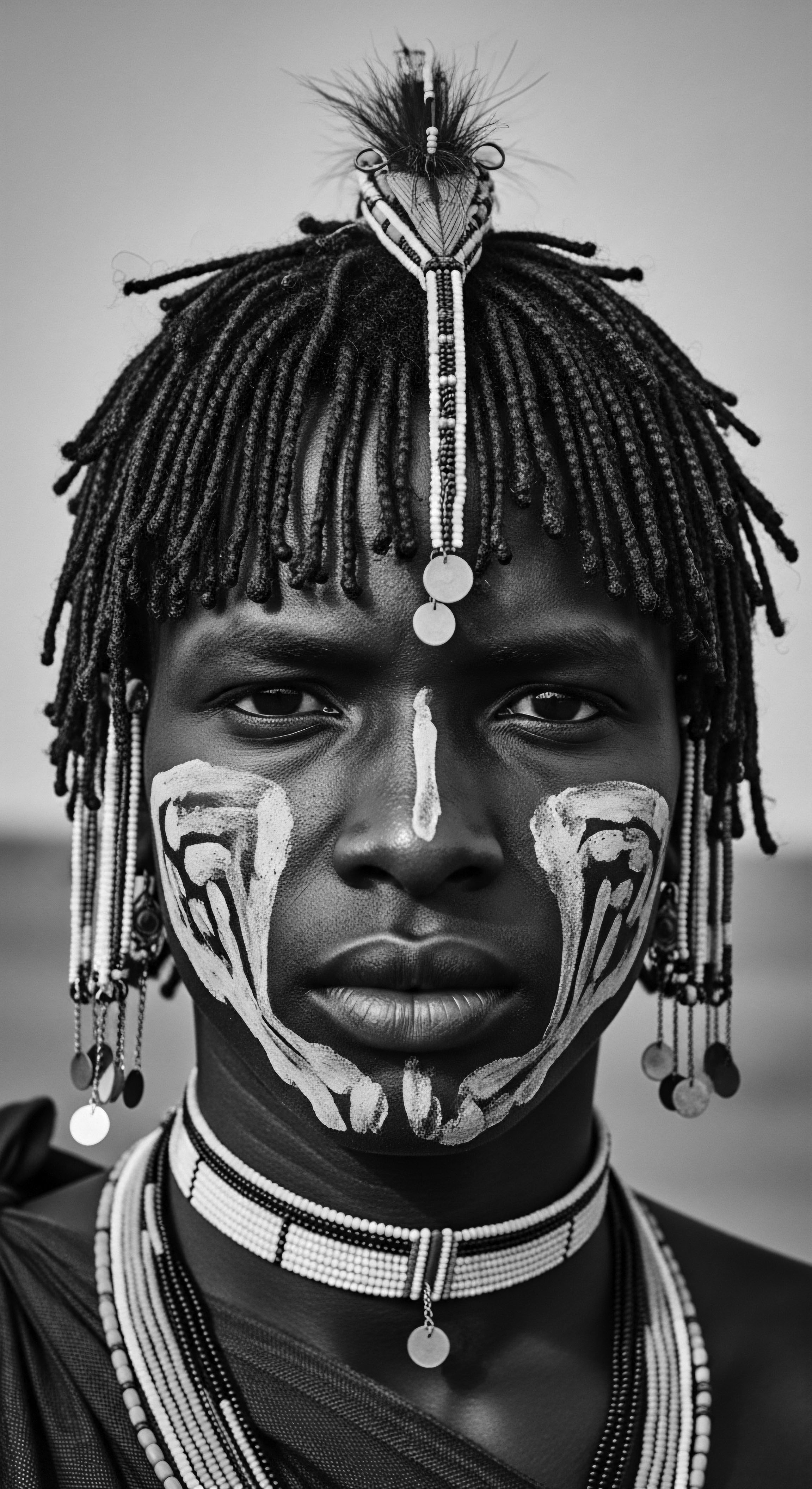
What Specific Historical Examples Illuminate Hair’s Societal Weight?
Consider the historical example of the Igbo Ichi Scarification Marks, which, while not a hair practice, stand as a powerful parallel to the body’s use as a canvas for communicating status and identity within ancient African societies. The Ichi marks, typically facial scarification, denoted that a man had passed through the first stage of initiation into the Nze na Ozo society, the most significant spiritual, religious, and social association among the Igbo people. This afforded individuals immense prestige, power, and influence within the community, authorizing them to perform rituals and designate titles. Historically, two styles of Ichi marks were recognized ❉ Mgbuzu Ichi, with lines from forehead to chin resembling sun rays, reserved for royal lineages, and Ntuche (ichi Nwadiokpala), with lines radiating across each temple.
While distinct from hair practices, the deliberate and painful process of applying Ichi marks, signifying noble status and spiritual authority, highlights the pervasive cultural practice of inscribing identity and standing onto the body. The connection here to textured hair heritage lies in the shared principle of body modification—whether through intricate braiding, unique head shaping, or scarification—as a language of belonging and rank. Both hair artistry and scarification were potent forms of non-verbal communication, often performed by skilled practitioners and deeply embedded in ancestral traditions.
The shift with the advent of colonialism and the transatlantic slave trade profoundly impacted these traditions. Forced hair shaving was an early, cruel act of dehumanization, aimed at stripping enslaved Africans of their identity and cultural significance. Despite this assault, hair became a tool of resistance. Some African women, particularly rice farmers, braided rice seeds into their hair before forced migration to the Americas, a desperate measure for survival of both themselves and their ancestral crops.
Cornrows served a dual purpose, also used to create maps for escape from plantations. This resilience, this enduring spirit to preserve heritage despite immense pressure, speaks volumes about the intrinsic value of hair as a marker of identity.
| Group Yorùbá |
| Hair Practice "Irun Kiko" (thread-wrapping) |
| Societal Marker Femininity, Marriage Readiness, Coming-of-Age |
| Group Himba |
| Hair Practice Otjize Locs (dreadlocks with ochre) |
| Societal Marker Age, Life Stage, Marital Status |
| Group Igbo |
| Hair Practice Isi Owu (threaded hair) |
| Societal Marker Youthfulness, Unmarried Status |
| Group Karamo |
| Hair Practice Shaved head with single tuft |
| Societal Marker Ethnic Identification |
| Group Benin Chiefs |
| Hair Practice Specific haircuts |
| Societal Marker Leadership Role |
| Group These diverse examples highlight the widespread and specific ways hair was used to convey a person's standing and heritage in various ancient African communities. |
Even in modernity, movements like Pan-Africanism and Rastafarianism represent attempts to revive certain aspects of ancient African hair culture, continuing the long relay of heritage and resistance. The natural hair movement of recent decades also reflects a reclaiming of ancestral beauty standards, a powerful affirmation of identity in the face of historical pressures.

Reflection
The deep currents of history, swirling with ancestral wisdom and enduring beauty, continue to shape the narrative of textured hair. What began as an elemental expression in ancient African societies—a reflection of status, identity, and spiritual connection—has journeyed through time, its legacy echoing in every coil, every braid, every proud crown worn today. The ‘Soul of a Strand’ whispers of a living library, where each hair practice, whether ancient or contemporary, forms a page in a continuous saga of resilience and profound cultural memory. This exploration has only scratched the surface of a heritage that is as vast and varied as the continent itself, a heritage that asserts the beauty and worth of natural texture not as a trend, but as an ancestral birthright.
The knowledge embedded in these traditions — from the symbolic adornments of Egyptian wigs to the communal braiding rituals of West Africa, and the life-stage markers of Himba locs — serves as a powerful reminder. It tells us that our hair is not just biology; it is also biography, a testament to the ingenuity, artistry, and spiritual depth of those who came before us. This legacy, passed through generations, invites us to recognize the profound continuity between ancient practices and modern expressions of identity, understanding that in caring for our textured hair, we also care for a piece of living history.

References
- EdwardAsare. (2021). The Role of Hair in Ancient African Cultures. EdwardAsare – Digital Marketer.
- FMACCE. (2021). Hairdo. FMACCE.
- Ozi Ikòrò. (2025). List of Igbo Women Traditional Hairstyles, Its Beauty and Significance. Ozi Ikòrò.
- Sieber, R. & Herreman, F. (Eds.). (2000). Hair in African Art and Culture. Museum for African Art, New York.
- The Gale Review. (2021). African Hairstyles – The “Dreaded” Colonial Legacy. The Gale Review.
- DiscoverYorùbá!. (2024). 7 Beautiful Traditional Yoruba Hairstyles – Irun Dídì Ni Ayé Àtijọ́. DiscoverYorùbá!.
- BLAM UK CIC. (2022). The history of Black Hair. BLAM UK CIC.
- Afriklens. (2024). African Hairstyles ❉ Cultural Significance and Legacy. Afriklens.
- Ogbonoblog. (2024). Common Igbo Hairstyles and Their Cultural Significance. Ogbonoblog.
- PhilArchive. (2023). The Ontology of Hair and Identity Crises in African Literature. PhilArchive.
- IROKO Theatre Company. (2024). Hair As Heritage. IROKO Theatre Company.
- What Every Dermatologist Must Know About the History of Black Hair. (2023). What Every Dermatologist Must Know About the History of Black Hair.
- Equiano’s World. (n.d.). Igbo scarification. Equiano’s World.
- Know Your Hairitage. (n.d.). African Culture. Know Your Hairitage.
